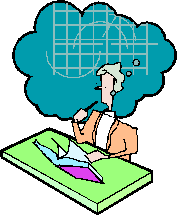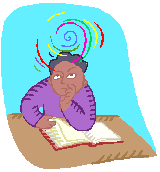





| |
Directed Imagination
Cherish your vision and
your dreams as they are the children of your soul; the blue prints of your
ultimate achievements.
Napoleon Hill
Directed imagination is the use of our imagination to implant particular
images into our designs. Later, when we are in those design situations, we will
tend to act out the images. The images can be those of a healthy body, or
objects that we want to own, or activities such as sports that we want to
master, or psychological qualities that we want to cultivate. Directed
imagination is similar to visualization.
 We use our imagination frequently throughout the day. We use it in our story
like fantasies and daydreams, and in our recall of memories, and in the mental
pictures that we create to help us understand concepts, and future activities
such as a vacation, for which we design our agenda by envisioning the places
that we will visit. For some people, the thinking process is composed primarily
of words, other people think primarily in pictures. Albert Einstein, whose
imagination helped to create the theories of relativity, said that very little
of his thought process involved words. We use our imagination frequently throughout the day. We use it in our story
like fantasies and daydreams, and in our recall of memories, and in the mental
pictures that we create to help us understand concepts, and future activities
such as a vacation, for which we design our agenda by envisioning the places
that we will visit. For some people, the thinking process is composed primarily
of words, other people think primarily in pictures. Albert Einstein, whose
imagination helped to create the theories of relativity, said that very little
of his thought process involved words.
How directed imagination works.
We implant images into our design. The images along with the thoughts, energy
tones, and actions become a permanent record of our interaction with the design.
The interaction is occurring only in our imagination rather than occurring in
our current physical circumstance. In future encounters with the design in our
imagination or in the physical world, these images will influence our perception
of, and response to, the design.
 Directed imagination is used successfully by professional people including
athletes. Ice skater Elizabeth Manley, and diver Greg Louganis, said that
imagery helped them to win their Olympic medals. It is also used to treat
medical disorders. Imagery helps people who have migraine headaches, obesity,
high blood pressure, and other ailments. We can use directed imagination in
concert with medical treatments. Directed imagination is used successfully by professional people including
athletes. Ice skater Elizabeth Manley, and diver Greg Louganis, said that
imagery helped them to win their Olympic medals. It is also used to treat
medical disorders. Imagery helps people who have migraine headaches, obesity,
high blood pressure, and other ailments. We can use directed imagination in
concert with medical treatments.
Techniques of directed imagination.
 |
We can combine the different types of design-work. While using directed
imagination, we can also use:
|
 | Modeling. Whenever we act as if, we can use directed imagination to
affirm the action that we are performing. If we are acting as if we are
peaceful, we can create images of a relaxing place such as a quiet riverbank. |
 | Design-work. We can use energy toning of emotions and feelings while we
do directed imagination:
 | If we are visualizing ourselves in a peaceful setting, we generate the
energy tone of happiness. If we are visualizing a desired object or a
condition such as a healthy body, we implant the tone of enthusiasm and
gratitude. |
 | We use personal images. We are more likely to evoke an energy tone if we
imagine a scene with which we have a personal affiliation. To evoke serenity,
we would imagine our favorite beach instead of a fabricated scene of a
generic beach. |
 | We enjoy the natural feeling of joy that arises when we use a pleasant
image. The joy occurs because the image increases the flow of life energy. |
 | We use the image with various energy tones. As explained in the chapter
regarding design-work, we are most likely to remember the images we implanted
when we were in an emotional state resembling our current state. When we are
depressed, we tend to refer to the same elements that we traditionally use
when we are depressed. We need to implant our images with a variety of energy
tones, so that those images will be the dominant elements in any mood that
occurs in the future. |
|
 | We generally refrain from creating images of unwanted conditions. Instead
of visualizing ourselves winning a battle against an intruder, we can create a
positive image of ourselves resting securely within the walls of an impregnable
fortress. |
 | We can use our body's physical energy. The body's vitality is added to
the image element if we use directed imagination while we walk, dance, exercise,
clean our home, or perform other movements. |
 | We can acquire images from various sources. For the purpose of directed
imagination, we use images from various sources:
 | An internal source. Such as our imagination, a fantasy, a dream, a
memory, intuition, or a vision. |
 | An external source. A photograph, a movie, a magazine or newspaper, a
web site, a television program, a physical object, a verbal description of an
image such as a book's description of a setting, or a person's description of
a vacation spot. |
|
 | We use different positions from which to view the object of our directed
imagination.
 | From the inside. We imagine a scene as though we are looking at it
through our own eyes. We see the surroundings, the other people, and the parts
of our body that we would normally be able to see, our arms, legs, and torso,
but not our head. |
 | From the outside. We visualize ourselves from an external point, as a
spectator of ourselves. |
 | From a specific person. We see ourselves as if we are looking through the
eyes of a particular person or group of people. We can see ourselves from the
viewpoint of our spouse, or a parent, or a judge at an ice skating tournament. |
 | We can use our other senses. For most people, imagination is primarily
visual. However, we have other options:
 | We can use a different sense, imagining sounds or smells or textures or
flavors. If we want to visualize comfort, we can imagine the aroma of our
mother's kitchen. |
 | We can use more than one sense. If we are imagining a new car, we can
smell the scent of a new car's interior. We can hear the sound of the engine.
We can feel the texture of the smooth steel. |
|
|
 |  We can allow ourselves to daydream and to fantasize. In our hurried, left
hemisphere oriented world and particularly in classrooms, daydreaming is not
encouraged. This activity is however a good way to access our intuition and to
enhance our ability to use or imagination. We can allow ourselves to daydream and to fantasize. In our hurried, left
hemisphere oriented world and particularly in classrooms, daydreaming is not
encouraged. This activity is however a good way to access our intuition and to
enhance our ability to use or imagination. |
 | We can use an animated image. Instead of viewing a stationary object, we
imagine a story with various settings, characters, and activities. |
 | We can use interesting images. We respond most readily to images that are
bright colorful and fascinating. |
 | We notice the images that we create with our words. Whether we are
speaking, or listening to another person, we often make pictures in our mind to
help us understand the words. In particular, we note the destructive imagery
that accompanies our visual expressions, in the example "He is a pain in
the neck", we are implanting the image of a painful neck. |
 | We relax. Images are associated with the right hemisphere of the brain,
so we need to increase the activity of that hemisphere by relaxing and drifting
into a dream like state, as though we are having an effortless fantasy or
daydream. |
 | We can visualize an object or an animal that we associate with a particular
quality. We can imagine a mountain when we want to develop stability. We can
imagine a cloud when we want to be serene. We can imagine a proud lion when we
want courage and self esteem. |
 | We can intentionally tighten our muscles slightly, as if we are
physically performing the activity that we are visualizing. If we are
visualizing ourselves talking, we create a small stimulation in the throat
muscles but not enough to speak. |
 | We can allow the image to take on a life of its own.
|
 | We do not use the physical eyes for directed imagination. Instead, we
close our eyes and then we create the image on the screen of our mind. |
 | We do not place the image directly in front of us, on the inner screen.
Instead, we will have more success if we put the picture slightly to the left,
right, top, or bottom. |
 | We can do a gentle visualization while we fall asleep.
|
 | We can expect improvement in our ability to use our imagination. Some
people cannot visualize at all. They need to start by simply thinking about the
image, or creating the feeling associated with the image, or making a very
simple picture. After we are able to make a mental image, we can develop our
ability to visualize:
 | See the blackness without any image. This will accustom us to the use of
our inner vision. See a single color such as a red blob. |
 | See a single shape such as a triangle in any color. |
 | See a particular shape in a particular color such as a blue square. |
 | See two colors in the same image such as a green star with a red border. |
 | See two images simultaneously such as a triangle inside of a circle. |
 | See one image, and move it. Move a square from the right side to the left
side of the inner screen. |
 | See one image, and alter it. Make a rectangle larger or smaller, or wider
or narrower, or taller or shorter. By altering the image, we can improve its
outcome. We can change the image of a basketball's flight, so that it does not
bounce off of the backboard but instead it goes straight into the basket. |
 | Change from one image to another. Start with a circle, and then delete that
circle, and see a square instead. |
 | Transform one image into another. Begin with a triangle, and change it into
a star. |
 | See an object that is three dimensional such as a cube. |
 | See the three dimensional object from various positions. Look at the cube
from the top, and then from one side, and then from another side. We can
rotate the object itself, or we can imagine moving ourselves to a different
position while keeping the object stationary. |
 | Visualize a familiar still scene that contains many objects such as a
living room, with a sofa, chairs, a carpet, wallpaper, a table, and so on. We
are recreating the scene from memory. |
 | Create a fictitious still scene such as a valley on Pluto. We are creating
the scene from our imagination. |
 | Create a scene in which there is movement such as a tree into which birds
are flying. |
 | Put yourself into the action, such as a forest in which we are walking.
Instead of watching the images as though they are on a movie screen, we
surround ourselves with the scenery, and then we take a walk through this
world. |
|
 | We can imagine scenes from books. We can spend time with a novel and
imagine the characters' actions instead of a television that offers a passive
experience in which we are not actively using our imagination. |
 | We explore the symbolism of images. The intuitive and intellectual
dimension of symbolism can add to our appreciation and use of imagery. To learn
more about symbolism, we can read books about the arts such as poetry,
photography, or film making. |
 | We can be aware of more visual details throughout the day. This will help
to develop our skill in seeing details internally. These same details can be
used in our directed imagination. If we make a point of noticing and remembering
a beautiful cloud formation, we can recall this memory when we want to visualize
a relaxing scene. |
Next topic: Modeling
|
